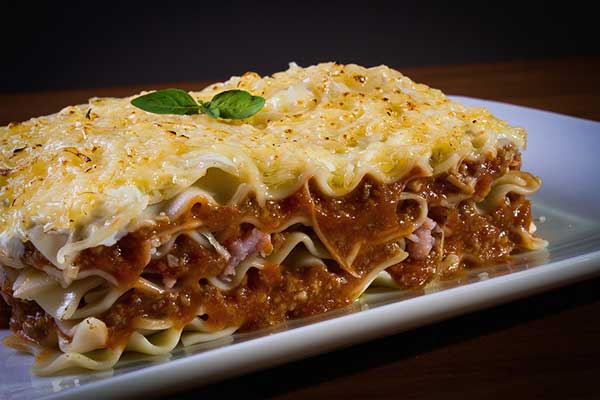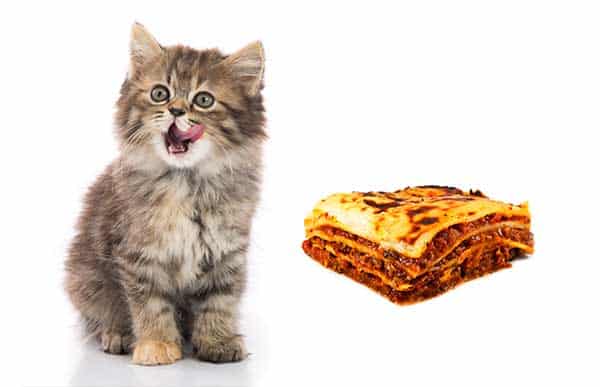Most pet parents already understand the position that vets hold with regards to offering human foods to their furry friends.
Generally, vets discourage feeding our pets human foods unless certain precautionary measures are observed.
For instance, cats should not freely eat fruits, veggies, or other plant-based foods, for the simple reason that they’re obligate carnivores. As an obligate carnivore, your feline friend is better off with a diet of animal protein.
Also, most human foods, be it meat or plant-based foods, are prepared in conditions that make them unsafe for cats to consume.
Take a case of lasagna, for example, and you might be wondering, should I feed my cat with lasagna?
The answer is a resounding NO. Cats should not eat lasagna. First, there are minimal nutritional elements that your cat will enjoy from a diet of lasagna. Most importantly, lasagna contains many ingredients that are potentially toxic to cats.
Read on as we address all the related questions on cats and lasagna.
Table of Contents
What Is Lasagna?
Lasagna, plural for lasagne, refers to an Italian dish that’s made of stacked layers of flat pasta and a wide assortment of fillings.
The most popular lasagna filling is ragu, which is essentially ground meats and tomato sauce. Other common lasagna fillings include vegetables and cheese (which may include parmesan, ricotta, or melted grated mozzarella cheese).
Once the pasta and fillings have been assembled, lasagna is seasoned using spices and condiments like garlic, onions, tomatoes, basil, parsley, oregano, etc.
Then, the dish is baked in an oven, resulting in lasagna casserole which is sliced into single-serving square parts.
Why You Shouldn’t Feed Lasagna to Your Cat? A Review of The Ingredients
As we’ve already highlighted, feeding lasagna to your cat isn’t a great idea. But you could still be wondering, can my cat eat lasagna even if it’s a small amount?
In order to answer that question conclusively, you’ll need to establish what the lasagna comprises of before offering it to your kitto. And since lasagna is made up of various ingredients, the safety of the food depends on that of its individual components.
Let’s dissect each ingredient and see how safe or toxic it can be for your cat.
1. Pasta
Pasta mostly comprises of carbohydrates, and carbohydrates aren’t toxic to cats. However, you’re better off not giving your feline friend carbohydrates either. As we already mentioned, cats can live entirely on a diet of animal protein.
Meat provides your cat with all the nutritional elements it can ever need. It’s also worth noting that the body of cats is designed to synthesize some of the minerals it cannot get from its regular diet of animal protein, such as vitamin C.
Therefore, feeding your cat carbohydrates like pasta is an act in futility.
Besides, carbohydrates, coupled with the high fat content in lasagne, might cause obesity to your cat.
For those of us who are acquainted with Jim Davies comic strip, Garfield, we know how the lazy, lasagna-loving Garfield cat kept on adding more weight.
So, watching Garfield eating lasagne in this sensational comic strip is enough reason not to offer the food to your cat. Unless you want your kitto to end up as fat and indolent as Garfield was.
2. Dairy Products
Most lasagne feature dairy products, particularly cheese.
In small quantities, cheese is a mild laxative and can be used to relieve feline indigestion.
However, you should also remember that cats are lactose-intolerant. They don’t have the required enzymes to digest dairy products.
Therefore, cheese, or any other dairy product used in lasagna, is only likely to cause your cat more harm than good.
So, is lasagna poisonous to cats?
Well, as far as pasta and dairy products are concerned, lasagna can, indeed, be poisonous to cats. But pasta and cheese aren’t the only reasons behind the toxicity of lasagna.
3. Seasonings
A typical lasagna usually contains up to five different spices. The most popular ones are garlic, onions, tomatoes, basil, parsley, and oregano.
Not to mention, salt. Out of these seasonings, tomatoes, parsley and basil are relatively safe for cats. Oregano is also somewhat safe, provided you don’t feed it to your cat in excess quantity or allow the cat to consume oregano essential oil.
However, cats should not eat garlic, onions, or salt. A small amount of these ingredients can cause severe toxicity for your feline friend.
Garlic causes garlic poisoning in cats, a severe condition that could be fatal. So, it’s only natural to find a cat owner wondering – my cat ate a very small amount of lasagne, I’m worried because there was garlic, onions and tomatoes in it.
The following are some of the symptoms of garlic poisoning;
- Gastrointestinal symptoms, such as vomiting, diarrhea, abdominal pain, and stomach irritation;
- Anemia symptoms, such as pale-yellow gums and the rupture of red blood cells (a condition known as Heinz body anemia);
- Difficulty breathing;
- Elevated heart rate;
- Lethargy; and
- Discolored urine;
Onions also carry their fair share of toxicity for cats. And since onion belongs in the same family as garlic, symptoms of onion poisoning in cats are similar to those of garlic poisoning.
And just like garlic and onions, salt is another highly toxic lasagna ingredient to cats. Excess salt causes sodium ion poisoning, a condition that’s also fatal.
The first symptoms of sodium ion poisoning include frequent drinking and urination, before the condition gradually develops to liver and kidney damage.
- EASY TO USE, IMPACTFUL RESULTS: Collect a sample, package it up, and send it securely back. Just register, swab, return with the...
- MOST COMPREHENSIVE BREED & TRAIT: Our test distinguishes over 20+ distinct breeds and 50+ trait markers with the most...
- SCREEN FOR 40+ GENETIC DISEASES: Get peace of mind by screening for 64 health markers associated with 43 diseases for which your...
Last update on 2025-02-04 / Affiliate links / Images from Amazon Product Advertising API
4. Meat
Now, the only ingredient in lasagna that might be considered healthy for cats to eat is meat, and is probably one of the reasons we enjoyed watching Garfield eat lasagne.
However, most meats used in the preparation of lasagne aren’t fit for feline consumption.
Therefore, you shouldn’t celebrate if you discover your cat eating lasagna, as the meat might turn out to be just as dangerous as the other ingredients we’ve reviewed here.
Other common lasagna ingredients that could be poisonous for your cat include sugars, fat, and wine.
Unveiling Cat-Safe Lasagne
After having thoroughly assessed the toxicity of lasagna, cat owners should generally avoid giving their cats this unhealthy food.
However, if you’re adamant about sharing lasagna with your kitto, there might be a safer way to do it. So, can cats actually eat lasagna?
Well, it turns out that they can, as long as you understand a safe way to share your lasagna with your feline friend.
The following is a cat lasagne recipe to get you started;
Ingredients:
- 6 lasagna noodles (one ounce each)
- 8 oz of Lean ground Italian seasoned turkey
- 1 link of Isnerio’s Italian sausage
- 1/4 of cup fresh eggs
- Partial package spinach
- 4 ounces of mozzarella cheese
- 2 cups of low or no fat cottage cheese
- 4 cups of Cat’s All-Purpose & Quick Tomato Sauce

Directions:
1. Cook your ground turkey and sausage over a pan till they’re done, then set them aside..
2. Mix eggs with cottage cheese and set aside.
NB: Don’t cook the noodles.
3. Add a half cup of sauce in a loaf pan.
4. Break your noodles to fit and cover the source using 1.5 noodles.
5. Cover the noodles using a ¼ of the meat as well as a ¼ cup of eggs or cottage cheese.
6. Add another 1.5 noodles, ½ cup of sauce, ¼ of meat, ½ spinach, and ¼ of cup cottage cheese.
7. Add another 1.5 noodles, 1 cup of sauce, ¼ of meat, ¼ of eggs or cottage cheese, and the last portion of spinach.
8. Add another 1.5 noodles, 1 cup of sauce, and the remaining portion of meat.
9. Top with 4 ounces of mozzarella cheese and cover the food using a foil.
10. Allow it to cook on an oven for 1.5 hours at a temperature of around 325 degrees and remove the foil to brown your cheese for a few minutes.
11. Serve and enjoy with your kitto.
Note: In case your your cat is diabetic, pregnant or suffers from kidney disease, please don’t feed her any lasagna.
Conclusion: Can Cats Eat Lasagna?
So, is lasagna bad for cats?
Yes, lasagna isn’t safe for cats and you should avoid offering it to your feline friend. But if you must, always prepare the food at home using a cat-friendly lasagna recipe.
Checkout Our Favorite Cat Products
1. Best Online Course For Cat Parents
Our favorite: The Cat Language Bible (How to Finally Undrestand And Speak to Your Cat) – A new form of cat to human communication that many cat owners have dreamed about… but few have actually thought possible.
2. Best Vacuum to Tackle Pet Hair
Our favorite: Dyson Ball Animal 2 – Engineered for homes with pets. With features and tools that dig out dirt, hair and allergens everywhere your pet gets.
3. Best Immune Support For Cats
Our favorite: Tomlyn Immune Support – Best Supplement for Cats and Kittens.



